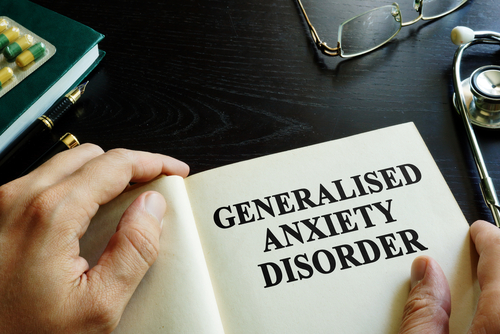Generalized anxiety disorder (GAD) is listed in the Diagnostic and Statistical Manual of Mental Disorders, Fifth Edition (DSM-5) as a mental illness and is characterized by “chronic anxiety, exaggerated worry, and tension, even when there is little or nothing to provoke it.” Perelman School of Medicine at the University of Pennsylvania asserts that the median age of onset of GAD is 30 years, although “a very broad range exists for the spread of age at the time of onset. Patients reporting a later onset of their GAD typically will say their symptoms developed in response to a significantly stressful event in their lives.” Johns Hopkins Medicine suggests that GAD can be triggered by situational circumstances such as family or environmental stress, chronic illness, or disease. Generalized anxiety disorder is not uncommon, and in any given year, GAD affects 6.8 million adults, which is equal to 3.1% of the U.S. population. The prevalence of GAD in children and adolescents ranges from 2.9% to 4.6%. GAD develops gradually and can begin at any age, but the years of highest risk are between childhood and middle age.
Signs and Symptoms
Generalized anxiety disorder can manifest as psychological symptoms, behavioral symptoms, and physical symptoms. Common examples of GAD symptoms may include any combination of the following:
- Psychological symptoms:
- Nervousness
- Irritability
- Nightmares
- A pervasive feeling of apprehension or dread
- Intrusive thoughts
- Feeling edgy, restless, or jumpy
- An inability to tolerate uncertainty
- Behavioral symptoms:
- Sleep disturbances
- Ritualistic behaviors (e.g., repeatedly washing hands)
- Inability to relax
- Difficulty concentrating
- Procrastinating
- Avoiding potentially anxiety-ridden situations
- Physical symptoms:
- Muscle tightness
- Body aches
- Fatigue
- Sweating
- Heart palpitations
- Dry mouth
- Cold or sweaty hands
- Trembling
- Shortness of breath
- Nausea
- Diarrhea
- Chronic headaches
Every individual is different, and the symptoms associated with GAD can vary in severity and duration and will be distinct to each person.
Causes and Risk Factors
To conclusively understand the precise cause of generalized anxiety disorder, additional research is required, however, clinical findings do point to a combination of biological, environmental, and psychological factors contributing to its development. Risk factors that may increase an individual’s propensity for developing generalized anxiety disorder could include both environmental and genetic factors, such as the following, provided by Healthline:
- Family history of anxiety disorders
- Recent or prolonged exposure to stressful situations, including personal or family illnesses
- Excessive use of caffeine or tobacco can exacerbate existing anxiety
- Childhood abuse or bullying
- Certain health conditions such as thyroid problems or heart arrhythmias
The University of Rochester Medical Center asserts that an imbalance of two chemicals in the brain (norepinephrine and serotonin) most likely plays a part in the development of GAD. Experts suggest that “those living with GAD may experience certain activation in areas of the brain associated with mental activity and introspective thinking when they encounter situations that could cause worry.” According to Winchester Hospital, it is not uncommon for other anxiety disorders to co-occur in a person with generalized anxiety disorder.
The information above is provided for the use of informational purposes only. The above content is not to be substituted for professional advice, diagnosis, or treatment, as in no way is it intended as an attempt to practice medicine, give specific medical advice, including, without limitation, advice concerning the topic of mental health. As such, please do not use any material provided above to disregard professional advice or delay seeking treatment.




